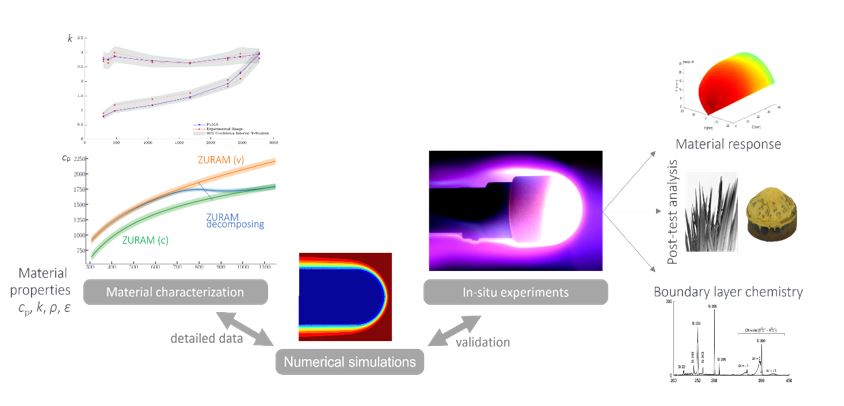Video Article Open Access
Material Properties Characterization and High-Enthalpy Experiments of Carbon-Phenolic Ablators and Space Debris Materials
B. Helber*, A. Fagnani, F. Torres-Herrador, A. Turchi, O. Chazot,T. E. Magin
Von Karman Institute for Fluid Dynamics, Rhode-Saint-Genèse, 1640, Belgium
Vid. Proc. Adv. Mater., Volume 2, Article ID 2111244 (2021)
DOI: 10.5185/vpoam.2021.11244
Publication Date (Web): 20 Jul 2022
Copyright © IAAM
Graphical Abstract

Abstract
In the field of advanced materials and material research, future space exploration missions are facing two main challenges: the thermal protection system must be designed to adequately protect crew and payload from extreme heating environments, while decommissioned spacecraft parts, so called space debris, must be destroyed during their re-entry at lowest possible heat fluxes.
Both approaches require experimental and numerical design tools, which are still subject to significant uncertainties due lack of material data in the high temperature environment, the limited knowledge of the material’s response and the associated complex gas-surface processes in their application range.
We will present our experimental methods to improve our understanding of the material response of the different types of materials ranging from low-density ablators and reinforced carbon composites to quartz and ceramic materials, as well as alloys and metals. Main objectives of the experiments are the production of high-quality data for the development and validation of high-fidelity numerical codes as well as engineering correlations.
The experiments span determination of relevant material parameters at high temperatures (specific heat, thermal conductivity, decomposition modes) and in-situ material testing in high-enthalpy plasma flows for reproduction of the reentry environment. For characterization of the material properties, we resort to typical test facilities such as Simultaneous Thermal Analysis (STA) or Laser Flash Analysis (LFA). The high-enthalpy experiments are carried out in the VKI Plasmatron ICP facility, which employs a comprehensive experimental setup, targeting recession of the surface as well as the radiative response of the different materials. For this purpose, we focus several calibrated radiometry instruments (Heitronic radiometer 0.6-39μm, Raytek 2-colour pyrometer 0.75-1.1μm, Optris 1-colour pyrometer 5μm) along with a high-temperature infrared camera (3-5μm) in the stagnation region of the test samples. This enables reconstruction of 3D emissivity-corrected surface temperature maps of the (possibly receding) material to be used for comparison with numerical codes. The boundary layer chemistry is generally observed by optical emission spectroscopy techniques, which allow identification of chemical processes at the surface or tracking the material decomposition over time. We will present recent results of the carbon-phenolic ablator ZURAM, representative of a conventional ablative material, as well as quartz, which responds with evaporation and shear ablation at sufficiently high temperatures, and titanium, particularly highlighting the complex surface chemistry in oxidative environments.
Keywords
Material characterization; high-enthalpy testing; ablation; space debris.
Acknowledgement
ESA GSTP and TRP programs (AblaNTIS, ReChar, Space Debris)
Air Force Office of Scientific Research
Flanders Research Foundation
Fonds de la Recherche Scientifique
References
- Helber, B.; Turchi, A.; Scoggins, J. B.; Hubin, A.; Magin, T. E.; International Journal of Heat and Mass Transfer, 2016, 100, 810-824.
- Torres-Herrador, F.; Turchi, A.; Van Geem, K. M.; Blondeau, J.; Magin, T. E.; Aerospace Science and Technology, 2021, 108, 106375.
- Fagnani, A.; Dias, B.; Schrooyen, P.; Helber, B.; Magin, T. E.; Chazot, O.; AIAA, 2021, 3137.
Video Proceedings of Advanced Materials

Upcoming Congress



